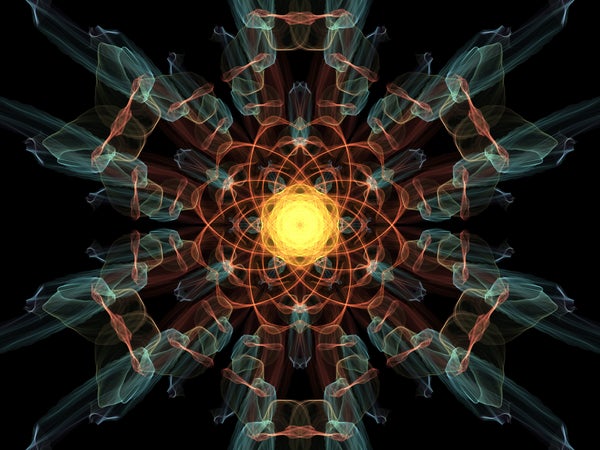We connect to each other through particles. Calls and texts ride flecks of light, Web sites and photographs load on electrons. All communication is, essentially, physical. Information is recorded and broadcast on actual objects, even those we cannot see.
Physicists also connect to the world when they communicate with it. They dispatch glints of light toward particles or atoms, and wait for this light to report back. The light interacts with the bits of matter, and how this interaction changes the light reveals a property or two of the bits—although this interaction often changes the bits, too. The term of art for such a candid affair is a measurement.
Particles even connect to each other using other particles. The force of electromagnetism between two electrons is conveyed by particles of light, and quarks huddle inside a proton because they exchange gluons. Physics is, essentially, the study of interactions.
On supporting science journalism
If you're enjoying this article, consider supporting our award-winning journalism by subscribing. By purchasing a subscription you are helping to ensure the future of impactful stories about the discoveries and ideas shaping our world today.
Information is always conveyed through interactions, whether between particles or ourselves. We are compositions of particles who communicate with each other, and we learn about our surroundings by interacting with them. The better we understand such interactions, the better we understand the world and ourselves.
Physicists already know that interactions are local. As with city politics, the influence of particles is confined to their immediate precincts. Yet interactions remain difficult to describe. Physicists have to treat particles as individuals and add complex terms to their solitary existence to model their intimacies with other particles. The resulting equations are usually impossible to solve. So physicists have to approximate even for single particles, which can interact with themselves as a boat rolls in its own wake. Although physicists are meticulous, it is a wonder they ever succeed. Still, their contentions are the most accurate theories we have.
Quantum mechanics is the consummate theory of particles, so it naturally describes measurements and interactions. During the past few decades, as computers have nudged the quantum, the theory has been reframed to encompass information, too. What quantum mechanics implies for measurements and interactions is notoriously bizarre. Its implications for information are stranger still.
One of the strangest of these implications refutes the material basis of communication as well as common sense. Some physicists believe that we may be able to communicate without transmitting particles. In 2013 a once amateur physicist named Hatim Salih even devised a protocol, alongside professionals, in which information is obtained from a place where particles never travel. Information can be disembodied. Communication may not be so physical after all.
This past April, the early edition of a short article about Salih’s protocol appeared online in the Proceedings of the National Academy of Sciences. Most of the article’s 10 authors were members of the University of Science and Technology of China, at its branches in Shanghai and Hefei. The final author was Jian-Wei Pan, an eminent physicist who has also developed a constellation of satellites for communicating through quantum mechanics. He recently used this network for transmitting entangled particles over a distance of 1,200 kilometers.
Pan and his collaborators publish at a rate of more than one paper a month. But the paper that they published in April, co-written by Yuan Cao and Yu-Huai Li, was exceptional. They described an experiment in which they sent a black-and-white image of a Chinese knot to a computer, without transmitting any particles.
Extraordinary claims require extraordinary evidence—even the person whose work dug the original foundation for the team’s evidence, Lev Vaidman, doubts their claim. Vaidman and others have been arguing about how to interpret such results for a decade. And their communication is now changing how we understand the quantum theory.
Physicists strain to comprehend what quantum mechanics whispers about reality and what we can know about the material world. The theory, however, is starting to speak up. Physicists now question the uncertainty that the quantum theory has imposed, as even weak measurements reveal particulars that were once thought impossible. At stake are the very notions of measurements and interactions, and the foundations of the information technologies of the future.
For if we can process information without particles, we may build a computer that need not turn on, and we may be able to communicate with absolute secrecy. There would be nothing to intercept and nothing to hack. This possibility derives from the information contained inside wave functions—and from the way that the imaginary manifests as real. So before we can disembody communication, we must give body to the quantum theory.
Embodying Quantum Mechanics
The basic instrument of quantum mechanics, from which all its oddities are composed, is the wave function. Every possible state of a quantum object, every possible outcome of its measurement, is a solution to the Schrödinger equation. This simple equation resembles the one that describes moving waves—enough to have confused Erwin Schrödinger into naming its solutions wave functions—but quantum waves are abstract, not real. Unlike the solutions for ocean breakers or sound, wave functions always contain imaginary numbers.
To obtain real answers from this complex math, physicists multiply a wave function by a negative version of itself. The result is the probability of observing an object with the properties that the wave function details. Summing all the squares of all the solutions for any quantum object always totals 100 percent. The Schrödinger equation accounts for every possibility. It confounds, but it does not surprise.
When we solve the Schrödinger equation to predict the location of a particle, there are usually many possibilities—much as there would be in establishing the precise location of surf. Positions and trajectories are ill-defined in quantum mechanics because of the well-known duality of particles and waves. But measurements offer a certainty that wave functions cannot. When we observe the location of an electron, we know it for sure. Such knowledge, however, has a price. Once we know the position, we cannot know the speed. If we measure the speed, we forfeit all knowledge of the position. This gnostic trade-off is called the Heisenberg uncertainty principle. Many other observables, such as time and energy, are equally incompatible.
One notable quirk of this mathematics is that combining solutions to the Schrödinger equation for any particular object, according to their probabilities, is also a possible solution. This is called a superposition, although that is a misnomer. One solution is not placed atop another, but rather they are added together into a blend. And as with juicing, the flavor of the whole surpasses what was added in.
Quantum mechanics is counterintuitive, and superpositions are why. We have never experienced one in our daily lives, despite the shifting probabilities and blends of truth that we live with. So, to understand superpositions, let’s consider a thought experiment that can be made real. This example illustrates most of the oddities of quantum mechanics, and underlies the actual experiments undertaken by Pan and his colleagues.
A Trick of Light
Point a laser toward a piece of glass coated partially with aluminum, as in a one-way mirror. If the glass is at an angle of 45 degrees relative to the incoming light, half the beam continues through and the other half reflects away, perpendicular to the original beam. There is no road less traveled by—the choice of path, like quantum mechanics, is perfectly random.
Now, set a regular mirror in each of these paths and reunite the beams. The light acts as a wave so the beams interfere with each other where they meet, producing a pattern of ripples on a fluorescent screen that glows where it is struck (Figure 1). The interference pattern on the screen looks like someone took a comb to it—a result equivalent to the famous double-slit experiment. But our setup has a fancier name—a Mach–Zehnder interferometer.
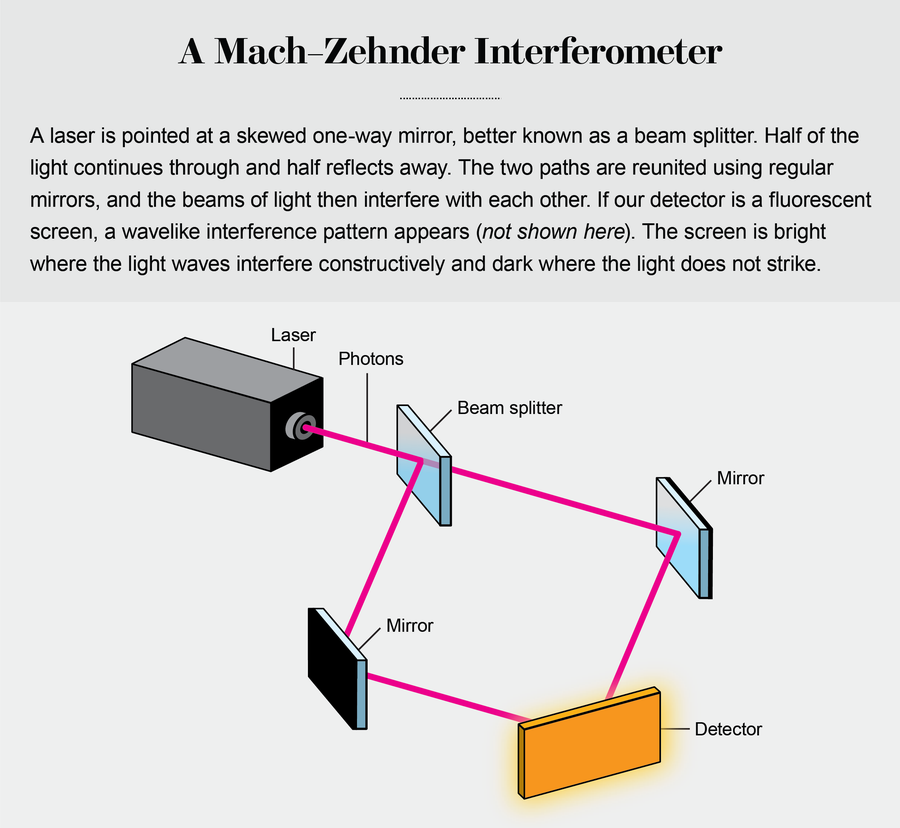
Credit: Jen Christiansen
We can alter the pattern on the screen by inserting a pane of glass in one beam’s path. Glass slows the light, so the peaks and valleys of its waves no longer match those from the other beam. A certain thickness of glass slows one beam just enough so its peaks arrive with the valleys of the other. Different areas of the screen now turn dark, where the light in the two beams interfere with each other destructively. If we were to place a photon detector at such a spot, no light would register.
Physicists have learned how to produce single photons and how to detect them (even with their eyes), so they often conduct such experiments using particles rather than beams. When they direct photons one at a time toward a one-way mirror, otherwise known as a beam splitter, half continue blithely through and the other half reflect away—the same as before with a beam. Nothing changes for single particles. Although only one photon travels on either path at a time, an interference pattern still emerges on the screen. We can even alter the pattern by inserting a pane of glass. Photons still act like waves. But what does each photon now interfere with? The answer to that question is the essence of quantum mechanics.
A photon cannot split in half and interfere with itself—we always detect photons whole. The photons exist as superpositions, so perhaps they take both paths at once. To explain superpositions, writers often say that a particle exists in two places at a time. But this is wrong.
If we place detectors on both of a photon’s possible paths, one always clicks and the other does not. If we place a detector in one path, it clicks half the time. Yet when a detector registers the photons on either path, an interference pattern no longer appears on the screen. Even if we interact with photons but let them pass, just to know where they are, the pattern still disappears. The act of a measurement, the very acquisition of knowledge, alters the result. Once we observe a particle, it does not act like a wave. Light may lead a double life, but it only leads one life at a time.
Schrödinger believed that wave functions corresponded to real objects. Since 1926, most physicists have interpreted the wave function as an abstract parcel of knowledge, not an inhabitant of our world. There is a sense, however, in which the mathematics must be real.
Whenever a photon is described by a superposition of paths, they somehow interfere. If we ruin the superposition by distinguishing the paths, the interference always disappears. Whenever we find out which path a photon takes, the other path is no longer possible. Wave functions detail possibilities. So after one path becomes impossible, the wave function changes to reflect our knowledge of the world. Physicists say the wave function collapses. The quantum world collapses, too. Superpositions are more tenuous than any of our classical experiences.
Blowing Up
In 1993, Avshalom Elitzur and Vaidman pushed interferometers past the surreal and into the absurd, with a thought experiment that others would make real. Instead of a fluorescent screen, imagine a second beam-splitter where the paths reunite (Figure 2a). Now place a detector in line with each possible path after the splitter. The photons are equally likely to proceed to either detector. Alter one of the original paths again by adding a pane of glass, so there is destructive interference at one detector but not the other—a photon always registers in the second detector, but never in the first. We can actually observe this.
Now place an obstacle in one of the paths after the original split. Half the photons are absorbed and the other half travel the unimpeded path. These unimpeded photons should proceed as before, to the second detector. They do not. Half register in the first detector, which did not click when there were two paths (Figure 2b). The interference disappears because the other path is no longer possible. The photons definitely travel the path without the obstruction, but somehow they know what happens to the other path and change their behavior accordingly. In fact, a photon appearing in the forbidden detector—just once—is enough to intuit the presence of the obstruction.
Elitzur and Vaidman claimed their thought experiment was an example of the nonlocality of quantum mechanics. Two particles born together can exist in a superposition of complementary properties—and as the particles separate across the universe, we can measure the property of one and instantly know the other. This interdependence is called entanglement. Classical objects have distant influences—the moon orbits the Earth, magnets attract metals—but these influences are communicated through local interactions, traveling no faster than light. Particles separated by a universe, however, lose their superpositions immediately. The photons on our paths have no mass or charge, so they do not emit physical influences across space. Quanta are still local. Yet somehow the photon on the clear path knows about the obstacle in the other path instantaneously, without interacting with it at all. The photon acquired information from afar.
“It is common to think that unlike classical mechanics,” Elitzur and Vaidman explained, “quantum mechanics poses severe restrictions on the minimal disturbance of the system due to the measurement procedure.” This cannot be true. A path may be undisturbed, yet our observations will change. The mere presence of an obstacle on the other path acts like a measurement, conveying information to the photons and to us.
Dennis Gabor,who developed holograms, said that every observation requires a photon. But light does not have to strike an object to reveal it. We can see without looking. (This is neither a shell game nor ESP. Most photons in the real world have many more than two possible paths, and these usually cancel one another, leaving the straight, shortest path for light, which we observe. Most light acts as we classically believe.)
Elitzur and Vaidman, who were then working in Tel Aviv, plotted their idea more dramatically (Figure 2b) Instead of an inert obstacle in one path, they imagined a bomb set to explode when struck by a photon. If a photon travels that path, the bomb explodes and we know for certain that the photon was there. If a photon travels the clear path, we can still discern the presence of an obstacle—in this case, the bomb—without shining a light on it. The photons on the unimpeded path will register in the forbidden detector half the time, alerting us to the bomb’s presence. Elitzur and Vaidman called this an interaction-free measurement. Sir Roger Penrose, the noble mathematical physicist, called their insight a counterfactual. But the thought experiment is not counter to established fact. Evert du Marchie van Voorthuysendemonstrated interaction-free measurements using inexpensive instruments—and obstacles other than bombs—at a science expo in Groningen, in 1995. Afterward, physicists could not explain the demonstration any better than the spectators.
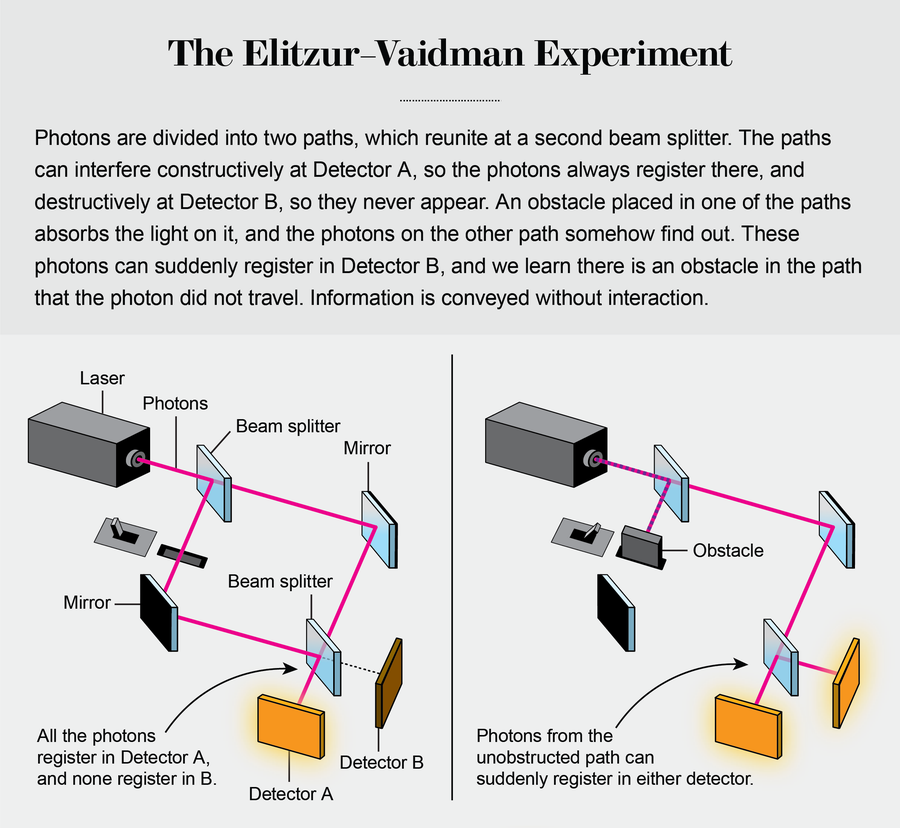
Credit: Jen Christiansen
Wave functions and superpositions describe actual phenomena with actual consequences. The mathematics is set; the interpretation is not. Some physicists believe, again, that wave functions are real objects, similar to a magnetic field. Others contend that wave functions describe ensembles, not single particles. Still others take the mathematics so seriously that they argue superpositions create many worlds, one for each possibility.
Most physicists insist that the math details only the many possibilities of our one world. But Elitzur and Vaidman converted themselves to the more radical idea. “This paradox can be avoided in the framework of the many-worlds interpretation,” they wrote. If there are many worlds, interaction-free measurements are easy to explain. The wave function does not collapse and every possibility still exists, somewhere—we discern an obstacle here because an explosion happened in another universe.
In the reckoning of Elitzur and Vaidman the probability of conveying information without interactions, in any universe, is at best 50 percent. But in 1994, two young men who had recently completed their PhDs in the Bay Area—Mark Kasevich and Paul Kwiat—met in the lab of Anton Zeilinger in Innsbruck. Kasevich told Kwiat, and a few other colleagues in Austria, how they might improve the odds. If an obstacle transmits information without interactions half the time, more obstacles should transmit information more frequently. Repeatedly splitting the paths in an interferometer and inserting obstacles in them is akin to repeating measurements and gaining knowledge from each one. Kwiat and his colleagues called this an interrogation.
In theory, physicists could extract perfect information without interactions if they used an infinite number of obstacles. In experiments, Kwiat and his colleagues routed one of the paths of a photon through an obstacle six times and increased the number of interaction-free measurements to 70 percent. During the 1970s, two physicists at The University of Texas at Austin, Baidyanath Misra and E. C. George Sudarshan, studied the weird capacity for repeated measurements to prolong quantum effects. They called it Zeno’s paradox for quantum mechanics. The Greek philosopher had argued that measuring the position of an arrow repeatedly, as it progresses half the distance to its mark, implies the arrow never lands. Half a distance always remains.
Counterfactuals
In the nearly 25 years since the introduction of counterfactuals, physicists have realized many applications that are less volatile than detecting bombs. In 1998, Kwiat and his collaborators at Los Alamos developed photographs of human hair inside an interferometer, on a path that light did not traverse. Two years later in England, two theorists, Graeme Mitchison and Richard Jozsa, described how to compute without interactions.
Quantum computers are hard to build, in part because measurements are heavy-handed. To know the outcome of an algorithm, we have to ruin the very superpositions on which such a computer runs. In 2006, Onur Hosten, Kwiat and other collaborators at the University of Illinois at Urbana–Champaign, appended a chain of quantum Zeno effects to counterfactuals and designed a quantum computer that could deliver information without running at all. “This is possible only in the realm of quantum computers,” they explained, “where the computer can exist in a quantum superposition of ‘running’ and ‘not running’ at the same time.”
When Vaidman read that theoretical computers need not be turned on to work, he thought Kwiat had bested him again, improving the efficiency of counterfactuals. But the idea is not as straightforward as discerning an obstacle on a path without light. As Vaidman says, Kwiat and his collaborators’ computer relies on “the absence of an object in a particular place, allegedly without [photons] being there.” But no information can come from nothing. After analyzing the experiment for several months, Vaidman explained that “the photon did not enter the interferometer, the photon never left the interferometer, but it was there.” The particle had to be where it could not, if information was derived from the absence of an object. Kwiat wrote that Vaidman’s interpretation is “nonsense.”
At the Electronics and Telecommunications Research Institute in South Korea, in 2009, Tae-Gon Nohtook the next logical step. Instead of a fanciful computer that does not have to run, Noh applied counterfactuals “to a real-world communication task.” He developed a protocol for sending a key to unlock shared data. When a photon travels the unobstructed path in an interferometer, the information acquired about the other path—through which the photon could not have traveled—may be used to reveal the secret key. The crests and troughs of the light can be made to undulate up and down or side to side, and this binary property (called polarization) can be used to encode bits. Information can then be transmitted through the obstructed channel, which the receiver controls. The sender and receiver also share regular information, but if they follow a simple protocol, no one can eavesdrop or steal their key. There is nothing to intercept—the photons live and die, as Noh explained, inside the sender’s device. Even stranger than the lack of a signal, he said, is “the mere possibility that an eavesdropper can commit a crime is sufficient to detect the eavesdropper, even though the crime is not in fact carried out.” He compared counterfactuals to the preemptive arrests in the film Minority Report.
In 2011, Pan and a few other collaborators in Hefei realized Noh’s “engrossing” scheme in the real world, on a tabletop in their lab. They sent a secure key—at a rate of 51 bits per second—over a kilometer of fiber-optic cable, although not without significant errors. Pan and his group did not achieve the fidelity needed to convert their science into a technology, but they claimed, “we have given proof-in-principle demonstrations.” Some information really could travel without particles.
While living in England in 2009, a young man named Hatim Salihread Noh’s paper and asked himself, “Why didn’t I think of that?” He had a degree in electronics but had taught himself quantum physics after reading a few popular books by Roger Penrose and attending seminars in York . A year later Salih returned to his native Sudan, where he marketed solar panels, and a friend invited him to be a visiting researcher at the King Abdulaziz City for Science and Technology in Saudi Arabia. He did not have a PhD, but with a colleague there and two other theorists at Texas A&M University, he took “the logic of counterfactual communication to its natural conclusion.” As they explained, “using a chained version of the Zeno effect, information can be directly exchanged between Alice and Bob with no physical particles traveling between them, thus achieving direct counterfactual communication.” (Instead of labeling senders and receivers A and B, physicists call them Alice and Bob.)
First, Salih and his colleagues devised a protocol for communicating some information without particles. Split photons down two paths and reunite them at a second beam splitter, as before. Now do this again and again, adding one interferometer after another (Figure 3a). Alter the paths with special beam splitters, so the photons always proceed to the same detector at the end. The theoretical Bob, who controls obstacles in the series of paths, can use them to send information to Alice’s detectors. If he lets a photon through, the guaranteed click at the first detector is defined as a 0 in binary logic. If he blocks the paths after every split, a photon very likely appears in the second detector, a result defined as a 1. Thus Bob transmits information to Alice, even when he does not let some particles through.
In theory this set-up transmits 0s with certainty, but the counterfactual information—the 1s transmitted without particles—are less reliable. Photons from the unimpeded path occasionally pass to the other detector that registers 0s, even if there are hundreds of obstacles.
But Salih and his colleagues then claimed that they knew how to accomplish what no one had before: Make each bit counterfactual. It should be possible to transmit signals between a sender and receiver simply by blocking the paths that a photon should never take.
After the initial split for the photons in an interferometer, divide one of these two paths again. Now add one small interferometer after another on this path, placing obstacles that Bob controls in each (Figure 3b). Many small interferometers are thus nested inside a large one, and this can be done again and again. The obstacles on the interior paths act as repeated measurements, and the more interaction-free measurements there are, the more efficient the communication will be. The paths can even be made to interfere, so the particles that arrive at Alice’s detectors can never travel the paths that Bob obstructs. They are truly blocked. But the detectors will still register differently when he obstructs his paths or not. Bob sends information without interacting with any particles.
The protocol that Salih and his colleagues designed is difficult to imagine, even inside a lab. So they conceived another protocol using a similar interferometer, one developed by Albert Michelson to determine the existence of the aether during the 1880s (and used, more recently, to detect gravitational waves). In a Michelson interferometer, light is again divided onto two paths, but mirrors reflect the beams back to where they originally split. They interfere there. Experimenters can nest these interferometers and distinguish the light where it interferes by the two polarizations, which serve as the bits.
At the end of their paper, Salih and his colleagues declared, “we strongly challenge the long-standing assumption that information transfer requires physical particles to travel between sender and receiver.” In 2014, they even obtained a patent on direct communication without “physically real” entities. Salih then founded a company, called Qubet Research, to monetize the idea.
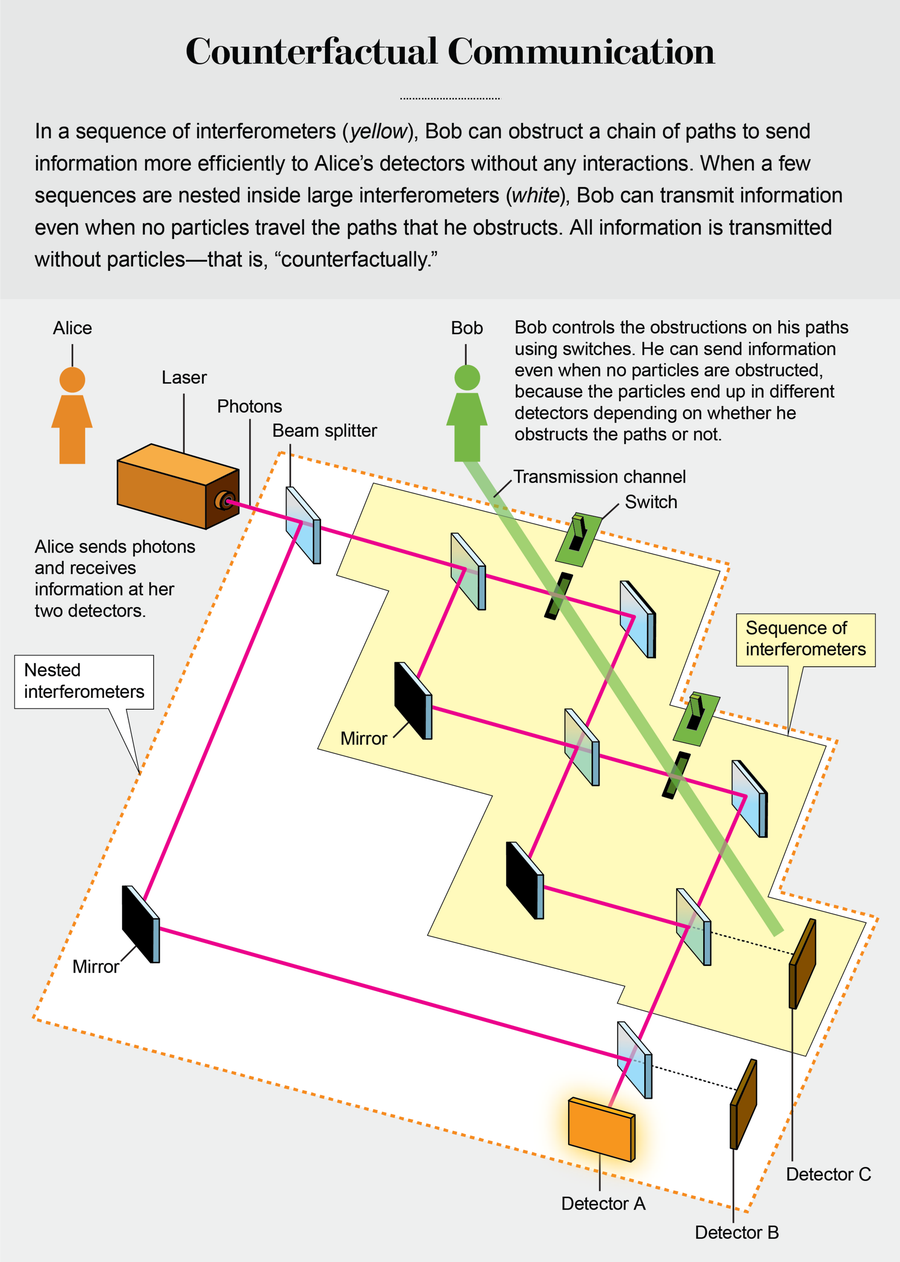
Credit: Jen Christiansen
Weak Measurements, Strong Opinions
Lev Vaidman is a prolific commenter. Twelve of his most recent 25 papers are replies to other physicists or criticisms of their work. He is sometimes impolitic enough to assert that someone’s paper should never have been published, but he also lists his rejected papers on his Web site. He comments so frequently, he says, because “open discussion and disagreements help to move physics forward.”
Physicists can agree on the mathematics and the results of experiments, but still dispute their interpretations. Perhaps surprisingly—but also rationally—Vaidman doubts that communication happens in the absence of particles, as Salih and others describe. Vaidman has complained that Salih et al.’s protocol “was based on a naive classical approach to the past of the photons.” He consented that a “process is counterfactual if it occurs without any real physical particle traveling between the two parties. But what is the meaning of this definition? For the quantum particle, there is no clear definition of ‘traveling’.” Vaidman’s argument is not just about language, but what we can say about the world.
Vaidman insists that particles have no past. And if they don’t, we cannot actually know if one was ever near an object and interacted with it. When we measure a particle to find out, the wave function that could have told us collapses. We do not learn history from particles, we force history upon them.
But, in 1988, Vaidman and two colleagues at the University of South Carolina imagined a new kind of measurement—one that was so weak that it did not collapse quantum states. A weak measurement cannot release the information we seek from photons, but coupled with many such measurements and one strong one, it might. In fact, a weak measurement followed by a strong one gives us more information than we have any right to know. Sending an electron through a slight magnetic field and then a strong perpendicular field, for instance, reveals two incompatible properties at the same time. Weak measurements disclose what Heisenberg had deemed uncertain.
Vaidman and his colleagues have converted their theory of weak measurements into a new version of quantum mechanics. They combine the information from a weak measurement and a strong one into a single wave function. The past is set by the weak measurement, and Vaidman then builds a superposition between the particle’s past and its future to know what happened in between. When Vaidman applies his theory to counterfactuals, the photon always appears where it should not—on the obstructed path. Few understand his approach, and many doubt it. The results are imaginary numbers that give negative probabilities, which should be impossible.
But in 2013, Ariel Danan and a few colleagues in Tel Aviv, including Vaidman, studied interaction-free measurements in actual weak experiments. They vibrated one of the mirrors on one of the paths inside an interferometer to locate the photons on this path. “The experiment is analogous to the following scenario,” they wrote. “If our radio plays Bach, we know that the photons come from a classical music station, but if we hear a traffic report, we know that the photons come from a local radio station.” What they heard was surprising. The photons flitted about, even on forbidden paths, guided by their wave functions.
Many physicists doubt that a photon that neither enters a path nor exits it can still somehow be there. Salih argues that Vaidman is using his own version of quantum mechanics, so he naturally believes that other interpretations are wrong. Salih even implied that Vaidman is telling photons what to say when other physicists interrogate them.
This past April, Pan and his colleagues wrote in their paper: “Although several publications are presently available regarding the theoretical aspects of [counterfactual communication], a faithful experimental demonstration, however, is missing.” It was time for an experiment on communication to speak. The group started planning their experiment to end the “heated debate” before Salih and others even formally published their idea.
An infinite number of interferometers was required for perfect communication, which Pan and his group acknowledged was impractical. So they simplified the protocol for Michelson interferometers and built four, with two smaller ones nested inside. They set their source of single photons, their beam splitters and their mirrors on a small table that was temperature-controlled and isolated against vibrations. The counterfactual communication would occur across 50 centimeters, inside a lab in Shanghai. Pan’s collaborators, Cao and Li, designed a number of possible images to send, and the group voted for a Chinese knot. As Cheng-Zhi Peng explained, “it is symmetric and beautiful.”
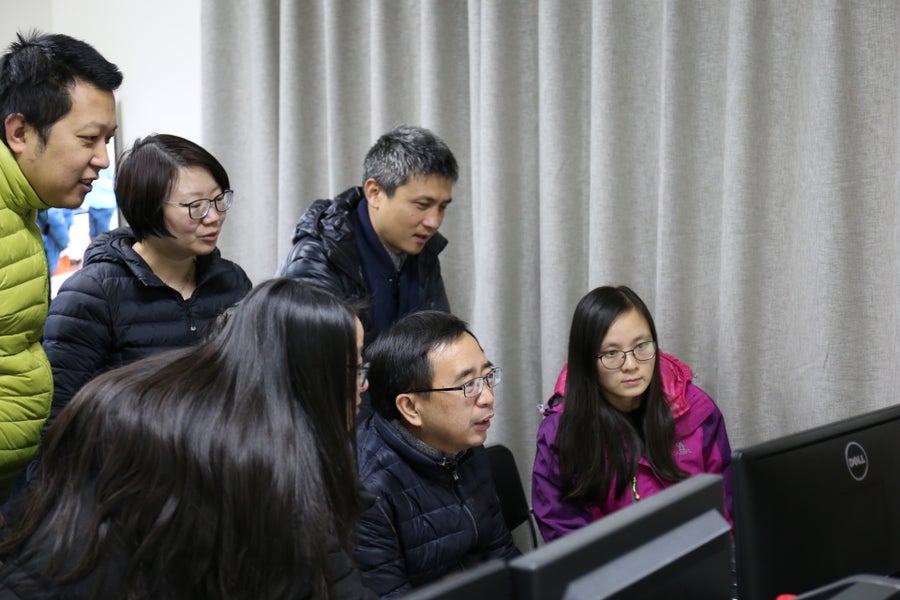
Jian-Wei Pan (seated at center) and colleagues in their lab in Shanghai. Credit: Bo Li
The group wrote software to run their experiment automatically, without any human interference. On May 31, 2013, they sat at a computer and waited through the night to see if the image loaded on a screen. They trusted their instruments, but they quietly hoped that nothing would appear. A negative result would imply that quantum mechanics is wrong. No one had ever observed that.
Over five hours, 10 kilobytes of information passed the 50 empty centimeters between the sender and receiver. Many of the bits had to be transmitted several times before they registered, and the computer was better at recognizing 1s than 0s. But a monochrome bitmap appeared through static, although the group had not transmitted any particles that they could discern. Once they saw the image, after sunrise, they disbanded to sleep before they celebrated. They posted a short article one year later but did not submit their paper for publication for more than three years. They were too busy building communication satellites, and they wanted some time to think about the result.
Pan and his colleagues are now working to transmit a picture in shades of gray, and they hope to send pure quantum information based on another protocol by Salih. To ensure that no photons pass through the transmission channel, they also plan to do a weak measurement to determine where the photon goes.
Although Pan is in the business of communication satellites, and counterfactuals pique banks and militaries, the group reported another potential application for their experiment: “imaging ancient arts where shining a light directly is not permitted.” Kwiat has implied that counterfactuals might not be useful for anything else. He wrote: “In order to achieve a high level of counterfactuality, one needs many cycles, and this greatly slows down the rate of communication.” Information moves slower without particles than with them.
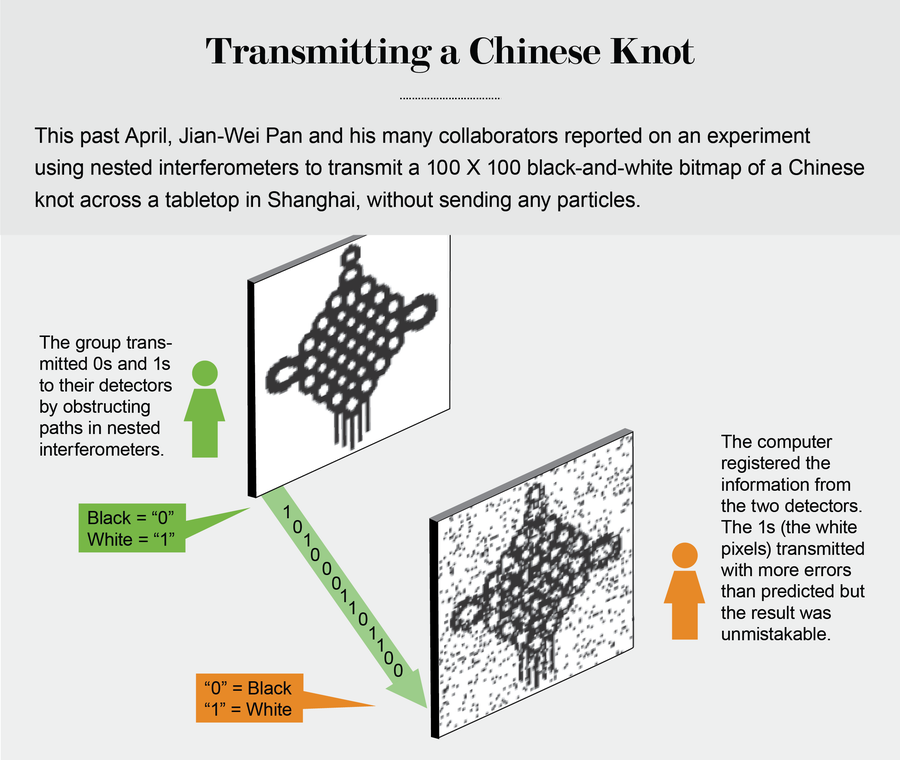
Credit: Jen Christiansen; Source: “Direct counterfactual communication via quantum Zeno effect,” By Yuan Cao et al., PNAS, No. 19, May 9, 2017 (Chinese knot panels)
Pan and colleagues attribute the mystery of counterfactual communication to the wave/particle duality. Salih has another interpretation. “I believe this experiment has something to say in support of the reality of the quantum wave function: If physical particles did not transfer information then what did?” Imaginary wave functions may be the last preserve of the real.
Salih is now working on a proof of counterfactuals, using weak measurements, to outflank his critics. When I asked Vaidman what would convince him that no particles were ever transmitted, he replied, tautologically: “If an object was found in a counterfactual way, there should be zero trace near it.” Pan’s collaborators told me, perhaps jokingly: “Although our demonstration hasn’t solved the issue entirely, we do believe that our work shed some light on the discussion.”
Quantum mechanics has survived nearly 100 years, and the unorthodox theory remains fabulous. Experiments routinely verify its predictions, and the normative theories invented to reform it have failed. Physicists continue to uncover new ways to adapt its mysteries to information technology and realize its wonders in the world. They are still waiting for the theory to communicate its meaning to us, however—with or without particles.
